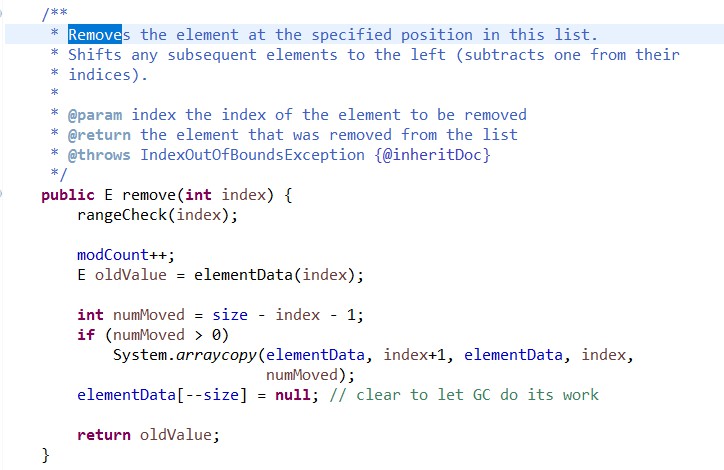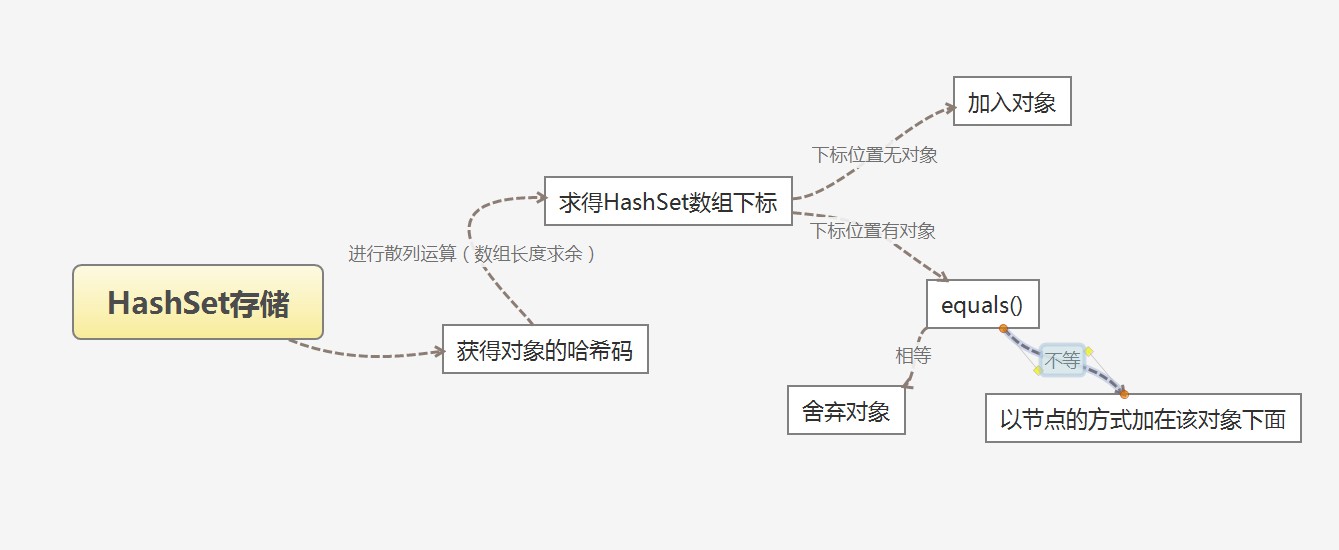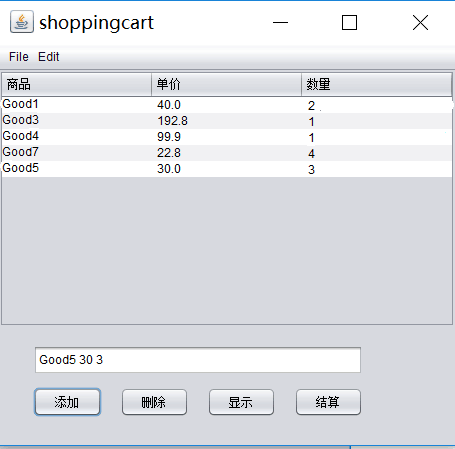第7周-集合
1. 本周学习总结
以你喜欢的方式(思维导图或其他)归纳总结集合相关内容。

参考资料:
XMind
——————————————————————————————————————————————————————————
2. 书面作业
1. ArrayList代码分析
1.1 解释ArrayList的contains源代码
answer:
首先,打开ArrayList的contains源代码:


其中可以发现这句话:Returns true if this list contains the specified element.字面上的意思呢(当然我也只能解释出字面上的意思),就是说“如果此列表包含了指定的的元素,就返回true”
而打开JDK Documentation,有可以发现更确切的解释:“当且仅当此列表包含至少一个满足 (onull ? enull : o.equals(e)) 的元素 e 时,则返回 true。”

——————————————————————————————————————————————————————————
1.2 解释E remove(int index)源代码
answer:
打开源代码:

其中的注释Removes the element at the specified position in this list.:“将列表中的指定元素移除。”以及Shifts any subsequent elements to the left:“将之后的元素向左移动”,其中真正起到这句话作用的语句是int numMoved = size - index - 1;
而这段源代码最后还有一段看似无关的代码:
if (numMoved > 0)
System.arraycopy(elementData, index+1, elementData, index,
numMoved);
elementData[--size] = null;
//因为经过移动,ArrayList的某个位置空了出来,所以需要加个这个多余的位置置为null
JDK Documentation解释:

——————————————————————————————————————————————————————————
1.3 结合1.1与1.2,回答ArrayList存储数据时需要考虑元素的类型吗?
answer:
(1)ArrayList储存的数据类型都是Object类,而Object类是所有类的父类,所以不需要考虑。
(2)而1.1与1.2的源代码中,并没有对ArrayList的数据类型有任何定义,所以不需要考虑。
——————————————————————————————————————————————————————————
1.4 分析add源代码,回答当内部数组容量不够时,怎么办?
answer:
add源代码:
public boolean add(E paramE)
{
ensureCapacityInternal(this.size + 1); // 检查当前集合中是否有空间可以装下新的元素
this.elementData[(this.size++)] = paramE; // 如果空间不够了,会自动扩容
return true;
// 注:ArrayList会分配连续的内存片段来储存集合的元素,因为内部其实是数组
}
———————————————————————————————————————————————————————————————————————————————————
private void ensureCapacityInternal(int minCapacity) {
if (elementData == DEFAULTCAPACITY_EMPTY_ELEMENTDATA) {
minCapacity = Math.max(DEFAULT_CAPACITY, minCapacity);
}
ensureExplicitCapacity(minCapacity);
}
private void ensureExplicitCapacity(int minCapacity) {
modCount++;
// overflow-conscious code
if (minCapacity - elementData.length > 0)
grow(minCapacity); //增加数组容量
}
ArrayList的add方法是在已存在的定长的集合中添加元素,当集合装满了,会在添加元素之前进行扩容。
——————————————————————————————————————————————————————————
1.5 分析private void rangeCheck(int index)源代码,为什么该方法应该声明为private而不声明为public?
answer:
private void rangeCheck(int index)源代码:
/**
* Checks if the given index is in range. If not, throws an appropriate
* runtime exception. This method does *not* check if the index is
* negative: It is always used immediately prior to an array access,
* which throws an ArrayIndexOutOfBoundsException if index is negative.
*/
private void rangeCheck(int index) {
if (index >= size)
throw new IndexOutOfBoundsException(outOfBoundsMsg(index));
}
使用private声明,说明此方法只在代码内部进行,而不能被用户获取到,而外部确实也没有用到这个方法的地方,这个方法主要是限制语句的操作范围,让使用者可以清晰地发现自己的语句操作越界,而这个rangeCheck操作主要是在代码内部进行,因此没必要使用private。
——————————————————————————————————————————————————————————
2. HashSet原理
2.1 将元素加入HashSet(散列集)中,其存储位置如何确定?需要调用那些方法?
answer:
(1)HashSet被称为集合,只能存储不重复的对象。
内部存储过程为:

(2)当HashSet存储对象时需重新对象对应的类中的equals()方法和hashCode()方法。
——————————————————————————————————————————————————————————
2.2 选做:尝试分析HashSet源代码后,重新解释1.1
answer:
/**
* 如果此set中尚未包含指定元素,则添加指定元素。
* 更确切地讲,如果此 set 没有包含满足(e==null ? e2==null : e.equals(e2))
* 的元素e2,则向此set 添加指定的元素e。
* 如果此set已包含该元素,则该调用不更改set并返回false。
*
* 底层实际将将该元素作为key放入HashMap。
* 由于HashMap的put()方法添加key-value对时,当新放入HashMap的Entry中key
* 与集合中原有Entry的key相同(hashCode()返回值相等,通过equals比较也返回true),
* 新添加的Entry的value会将覆盖原来Entry的value,但key不会有任何改变,
* 因此如果向HashSet中添加一个已经存在的元素时,新添加的集合元素将不会被放入HashMap中,
* 原来的元素也不会有任何改变,这也就满足了Set中元素不重复的特性。
* @param e 将添加到此set中的元素。
* @return 如果此set尚未包含指定元素,则返回true。
*/
public boolean add(E e) {
return map.put(e, PRESENT)==null;
}
——————————————————————————————————————————————————————————
3. ArrayListIntegerStack
题集jmu-Java-05-集合之5-1 ArrayListIntegerStack
3.1 比较自己写的ArrayListIntegerStack与自己在题集jmu-Java-04-面向对象2-进阶-多态、接口与内部类中的题目5-3自定义接口ArrayIntegerStack,有什么不同?(不要出现大段代码)
answer:
关键不同点在于
05-5-1:
private List<Integer> list;
public ArrayIntegerStack() {
list = new ArrayList<Integer>();
}//使用ArrayList存储,可自动扩容
04-5-3:
private Integer[] stack;
private int num;
public ArrayIntegerStack(int n) {
this.stack = new Integer[n];
} //使用内部数组,需提前定好数组大小
——————————————————————————————————————————————————————————
3.2 简单描述接口的好处.
answer:
就这题而言,虽然 两个ArrayIntegerStack方法同名,但却都是对IntegerStack接口进行不同的实现,而接口的好处就是在功能相类似具体方法又不同时,可以使用相同的方法名,不同的实现,从而根据自己的需求,通过不同的方式来实现。
——————————————————————————————————————————————————————————
4. Stack and Queue
4.1 编写函数判断一个给定字符串是否是回文,一定要使用栈,但不能使用java的Stack类(具体原因自己搜索)。请粘贴你的代码,类名为Main你的学号。
answer:
public class Main201521123084 {
public static void main(String[] args) {
// TODO Auto-generated method stub
Stack<Character> stack = new Stack<Character>();
Scanner scanner = new Scanner(System.in);
int a = 1;
String string = scanner.next();
for (int i = 0; i < string.length(); i++) {
stack.push(string.charAt(i)); //入栈
}
for (int j= 0; j < string.length(); j++) {
if (stack.pop() != string.charAt(j)) {
//一个个出栈并与字符串进行对比
System.out.println("no");
break;
}
else {
System.out.println("yes");
break;
}
}
}
}
——————————————————————————————————————————————————————————
4.2 题集jmu-Java-05-集合之5-6 银行业务队列简单模拟。(不要出现大段代码)
**answer:**
这题使用了ArrayDeque(双向队列),其中关键poll()方法:获取并移除此双端队列所表示的队列的头(换句话说,此双端队列的第一个元素)。
关键代码:
for (int i = 0; i < n; i++) {
if(q1.size() == 2){
System.out.printf(q1.poll()+" "+q1.poll()+" ");
if(q2.size()>=1)
System.out.printf(q2.poll()+" ");
}
if(number[i]%2 == 1)
q1.add(number[i]);
else
q2.add(number[i]);
}
while(q1.size()>1)
System.out.printf(q1.poll()+" ");
if(q1.size()==1)
System.out.printf(q1.poll()+"");
while(q2.size()>1)
System.out.printf(q2.poll()+" ");
if(q2.size()==1)
System.out.printf(q2.poll()+"");
——————————————————————————————————————————————————————————
5. 统计文字中的单词数量并按单词的字母顺序排序后输出
题集jmu-Java-05-集合之5-2 统计文字中的单词数量并按单词的字母顺序排序后输出 (不要出现大段代码)
5.1 实验总结
answer:
本题使用了TreeSet。
Set<String> strSet = new TreeSet<String>();
int n = 10;
while (scanner.hasNext()) {
String str = scanner.next();
if (str.equals("!!!!!"))
break;
else if(!strSet.contains(str))
strSet.add(str);
}
System.out.println(strSet.size());
strSet.toArray();
if (strSet.size() <= 10) {
for (String s : strSet) {
System.out.println(s);
}
}
else
for (String s : strSet) {
if ( n-- <= 0)
break;
System.out.println(s);
}
——————————————————————————————————————————————————————————
6. 选做:加分考察-统计文字中的单词数量并按出现次数排序
题集jmu-Java-05-集合之5-3 统计文字中的单词数量并按出现次数排序(不要出现大段代码)
6.1 伪代码
answer:
遍历text的每一个单词
建立map映射;
if(str重复出现)
键值+1
else
键值=1
6.2 实验总结
——————————————————————————————————————————————————————————
7. 面向对象设计大作业-改进
7.1 完善图形界面(说明与上次作业相比增加与修改了些什么)
answer:
上一次完成了登陆界面和结算界面,这次利用老师给的JTable框架改动我们的购物车,界面如下

——————————————————————————————————————————————————————————
7.2 使用集合类改进大作业
answer:
前面的购物车是用ArrayList进行商品信息的存储,而本周学习了集合,集合类有List,Set,Queue,Map,而实际上,Queue类没办法或者说没有必要应用到购物车或者商品信息的存储上。Set则可以用来检查购物车内是否有相同商品。Map则是用来给商品排序。。。。。然而我都结合不了( ╯□╰ ),感到非常的羞愧。
——————————————————————————————————————————————————————————
3. 码云上代码提交记录及PTA实验总结
题目集:jmu-Java-05-集合
3.1. 码云代码提交记录
- 在码云的项目中,依次选择“统计-Commits历史-设置时间段”, 然后搜索并截图

——————————————————————————————————————————————————————————
3.2. PTA实验
- 编程(5-1, 5-2, 5-3(选做), 5-6)
- 实验总结已经在作业中体现,不用写。
